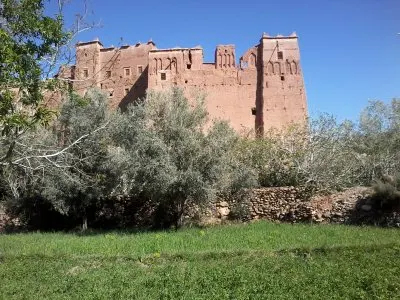These are some of the bays where Jews lived in Morocco
These are some of the bays where Jews lived in Morocco
 |
| toundoute kasba |
The kasbahs are fine jewels that adorn the field of oases in the south of Morocco, especially with the Draa and Tafilalet and the eastern Dades basins, Mkouna and Tidgha, a cultural heritage that some of them classified as human heritage, as is the case with the Kasbah of Ait Benhaddou in the Ammarzakan district, but the reality of the rest of the kasbahs, which number more than a thousand, is very miserable and is heading towards vanishing and ruin to be erased with it Architectural and civilized memory due to several combined factors related mainly to the economic and social reality resulting from the complete marginalization that this region has suffered for decades, whereby the country and the people are treated with a folkloric logic that is nothing but
 |
| These are some of the bays where Jews lived in Morocco |
In addition to the natural factors, such as the successive years of drought and desertification, which crept into the oases and forced the inhabitants to migrate, leaving their palaces and qasabath facing their inevitable fate, in addition to the encroachment of cement and the abandonment of the local architectural style, which caused a distortion of privacy and aesthetics that characterized the architecture of the southeast, not to mention the absence of interest on the part of successive governments that The region is known only during the tourist seasons or the hypnosis festivals that have been pursued for years to besiege the culture of enlightenment and modernity.. Modernity here does not mean that we ignore our distinguished and brilliant architectural heritage
 |
| ait hamou said kasbah a toundoute |
The oasis area that includes these oases is threatened today, which was confirmed by Mohamed El Yazghi recently in Errachidia during the presentation of the Tafilalet oasis rescue project when he said
The oases formed not only a link in the history of Morocco, but also in the history of the Arab Maghreb, as well as the establishment and support of Morocco’s relationship with the sub-Saharan countries, which are areas of national and global geographical dimensions. Connect the desert and the Mediterranean bioclimatic zone
The oases provide us with a unique and wonderful global model for what we call sustainable development today, which necessitates us to maintain the continuity of this model and this global cultural and ecological heritage, and that all oases are in danger, and if the situation continues in the same current direction, it will inevitably lead to extinction.. and it is no longer possible. Covering up the justification of natural conditions to explain the oasis crisis, as the crisis is the result of the interaction of several factors, the most important of which is related to the human element
 |
| Imgran village of Ouarzazate |
Indeed, the hand of humans extended to harm this cultural and civilizational heritage, as cement began to invade the region.. Modern buildings occupy the place of beautiful stalactites, degrading their distinctive architectural character.. About this, one of its visitors says
It is really unfortunate that the buildings of the old architectural style have been transformed with their beautiful splendor and civilized depth, which indicates a high aesthetic sense among the residents of the region.. It is unfortunate to see them transformed into disgusting gray concrete boxes, causing a terrible distortion in the harmony and consistency of the architectural space of this region.. And the worst of this What some residential communities know is bad in preparing the field, where we find buildings of an old nature, surrounded by new buildings with a different design.. It is really a civilized counterfeit that must be confronted
 |
| imish kasbah in toundoute imghran ouarzazate morocco |
Some researches say that the architectural aspect of this area has passed through three basic stages.. The first is characterized by a compact housing surrounded by huge and high walls, its buildings are very cohesive to save space.. Its building materials are bricks, coffins, wood and reeds.. which are local materials, and these are called The gatherings are called "Egraman" or palaces.. They are characterized by their vertical extension and are located next to the cultivated fields in order to monitor and guard them
 |
| imish kasbah in toundoute imghran ouarzazate morocco |
As for the second stage, it came after the construction of the main road and the end of the Siba period, which made security spread, which encouraged the population to leave the old palaces and spread along the main road as an economic facilitator and a link to the outside world.. The demographic growth is no longer absorbed by these palaces
 |
| These are some of the bays where Jews lived in Morocco |
The third stage, which is the stage after the seventies in which migration to the outside strengthened, which made the cement crawl with full force, so the architecture began to take a developed form, but it was imprinted with randomness and did not exceed the previous one except by using cement and iron materials. A resident says
 |
| These are some of the bays where Jews lived in Morocco |
What really surprised him is that these immigrants waste their money in building huge houses that are closed throughout the year.. Huge budgets were spent in them that could have been directed to building projects that would criticize the unemployed and exempt them from waiting for the immigrant’s daughters to be displaced abroad.. Our original architecture has been transformed into precious masterpieces by preserving and restoring it. Why not turn some of it into museums
 |
| These are some of the bays where Jews lived in Morocco |
The Thousand Kasbah Road is characterized by several historical kasbahs, meaning in beauty... in terms of their design or the diversity of their decoration, but today they are heading towards destruction, and we may wake up one day to find in their place a pile of dust... A tourist says
 |
| These are some of the bays where Jews lived in Morocco |
I suffer greatly for the state of these reeds, whose artistic and architectural value has not been appreciated, and I wonder how the officials let this beauty vanish
 |
| These are some of the bays where Jews lived in Morocco |
Indeed, this foreign tourist is jealous of our architectural heritage, but officials, including the Ministry of Culture and Tourism, did not attach any importance to these kasbahs
 |
| These are some of the bays where Jews lived in Morocco |
One has no choice but to take pictures of it so that it will remain as a memory as long as it will inevitably disappear one day, and it is a warning directed to all those concerned because it is a shame that this nation remains without memory
Let us contemplate the reality of some of these reeds, in order to truly realize their status:
Kasbah Amish Farrakhan Amgrane, east of Ouarzazate
 |
| These are some of the bays where Jews lived in Morocco |
It is considered among the forgotten and marginalized kasbahs, but more than that, the residents of the region contributed to the sabotage of this important historical heritage in the region. The case of Amish is like many other kasbahs, such as Kasbah, Omelot, Al-Hasai Kasbah in Tazki, Kasbah Akhwa in the same roundabout and others








